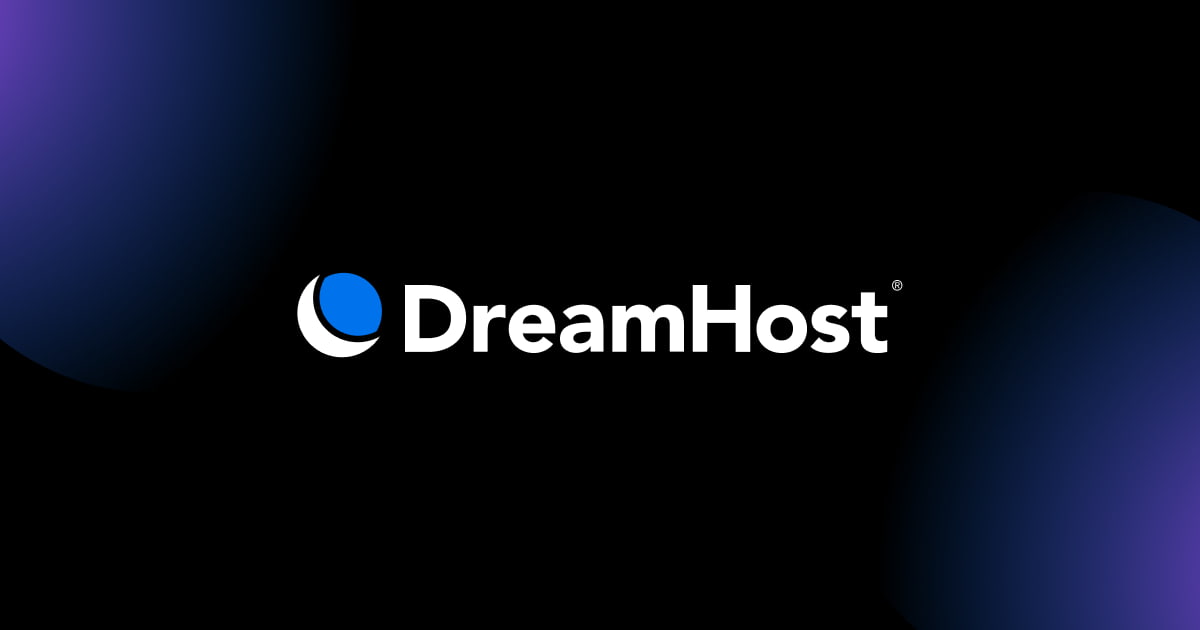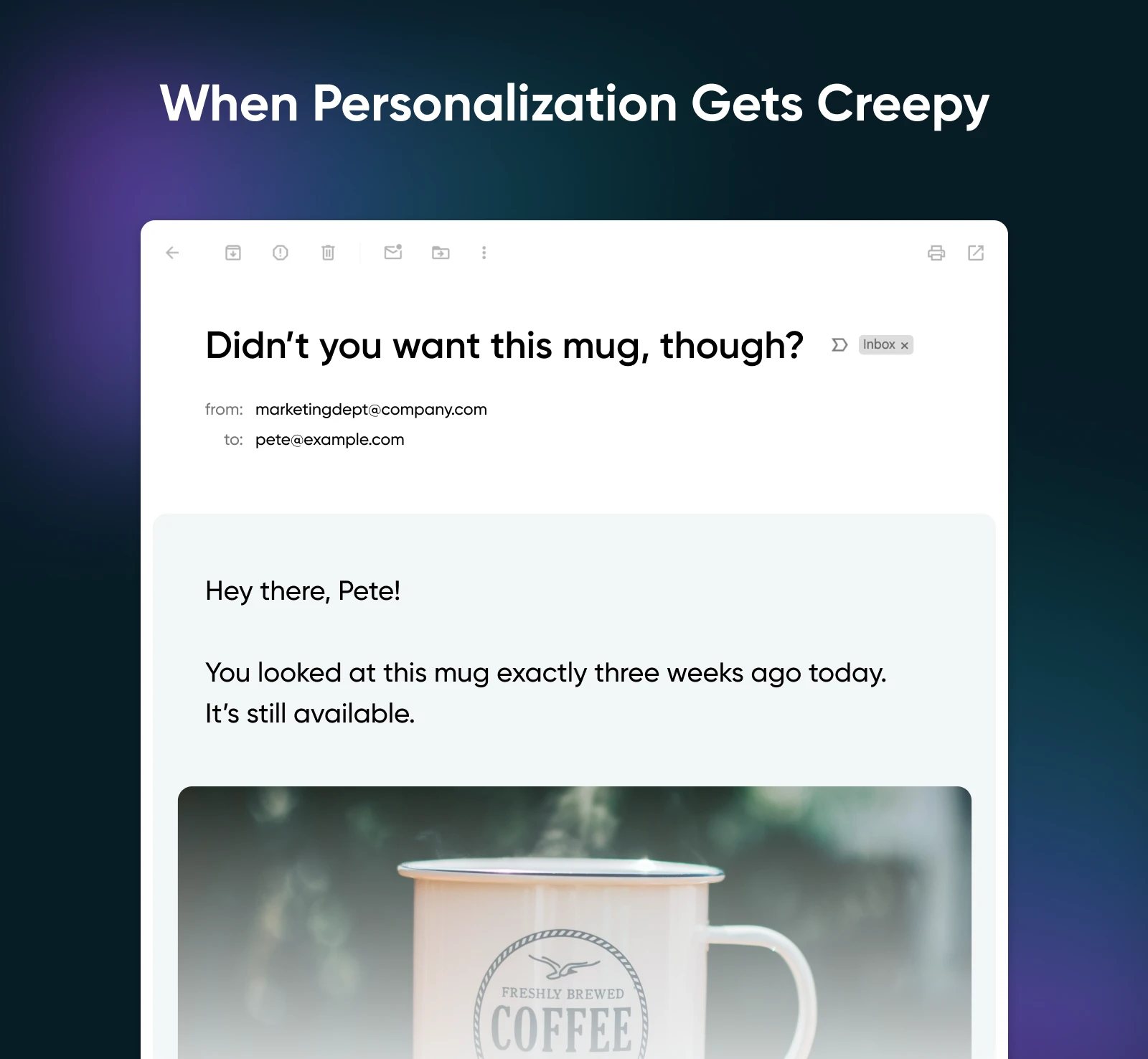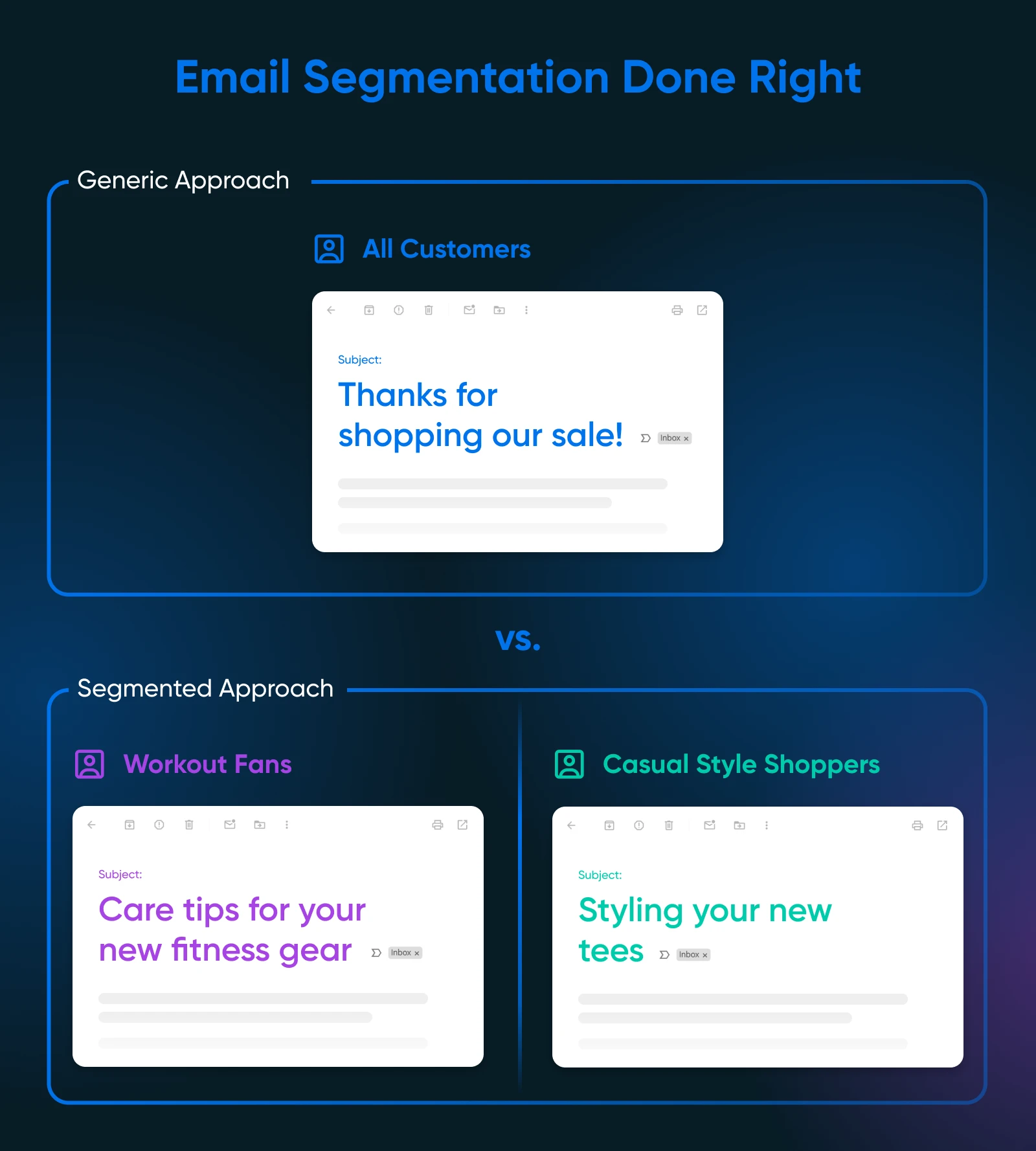3 Simple Ways To Personalize Emails That Feel Authentic and Human

Ever read an email that felt like a nosy neighbor wrote it?
It starts with “Hey there, [Name]!” and then mentions that very-specific-to-a-niche-1970s-British-murder-mystery-series-coffee-mug you browsed one time with a question that feels, frankly, too familiar for the circumstances: “Did you forget about this mug that would look great with your morning coffee in it?”

Yikes. Personalization is supposed to make shoppers feel special. But when it’s done wrong, it’s less “I see you” and more “Are you looking through my windows right now?”
The good news is, personalizing emails doesn’t have to be creepy —or complicated. In this article, we’ll explore how to make your subscribers feel like you’re chatting with them, not blasting them with a digital firehose of marketing. Stick around if you’re ready to level up your open rates, clicks, and (most importantly) genuine customer connections.
We’ve got three simple strategies you can start using right away. Let’s do this, minus the awkward mug references.
What Is Email Personalization (and Why It Matters)
Email personalization is the practice of tailoring your messages to match individual recipients’ preferences, behaviors, or demographic data. It’s not just slapping a first name in the subject line (though that’s part of it).
True personalization means using insights (like past purchases or stated interests) to create emails that resonate with each subscriber on a personal level.
Why Does Personalization Matter?
Email personalization has tons of benefits for businesses of all sizes:
- Higher open rates: Personalized subject lines can boost your open rates by up to 26%, according to Campaign Monitor. People are more likely to click on something that feels relevant to them.
- Better engagement: When an email aligns with a reader’s interests or past behavior, it’s more likely they’ll read through, click a link, or even hit “Reply.”
- A competitive edge: In a sea of generic marketing emails, a personalized message can help your business stand out. Small business owners especially need every advantage they can get against bigger brands.
- Stronger relationships with your customers: When subscribers feel seen and understood, they’re more inclined to trust and support your brand. Authentic communication can turn a casual subscriber into a loyal customer.
Common Misconceptions About Email Personalization
Before we dive into the three tactics we’re going to explore, let’s cover some tactics you’ve probably heard about, but should avoid.
1. “Using Their Name Is Enough”
Yes, “Hi [FirstName]” can be a good start, but these days, it’s hardly the pinnacle of personalization. If that’s the only change you make, your emails might still feel cookie-cutter.
Think of name usage as the bare minimum and build from there.
2. “You Should Go All-In on Personal Data”
As we covered in the mug scenario, over-personalization can come off as invasive, especially if you reference private or highly specific details the recipient never explicitly shared. Just because you have data doesn’t mean you need to use all of it.
3. “Personalization = Automation”
While automation tools make personalization easier, true authenticity requires a human touch. Automated content that doesn’t consider tone, context, or your brand’s voice can end up sounding robotic, and these days, customers are looking for authentic voices.
Keep these misconceptions in mind as we move into the real meat of this post: three techniques you can implement right now to make your emails feel more like friendly, relevant notes and less like pushy sales pitches.
3 Ways To Personalize Emails Without Sounding Robotic
You’ll see why each tactic works, examples of how you might apply it, and the next step you can take for making it happen in your own campaigns.
1. Segment Your List and Reference Past Interactions
Segmenting your subscriber list means you’re sending messages to targeted groups rather than blasting the same email to everyone. This matters because different segments have different interests. If you lump them all together, your content might fall flat for a large portion of your audience.
But by referencing a subscriber’s past actions — like a workshop they attended or an item they purchased — you show them you’ve been paying attention in a warm, non-creepy way.

Example In Action
Let’s say you run an online clothing store. After your summer sale, you notice some customers bought workout gear while others stocked up on casual T-shirts. Instead of sending a generic “Thanks for shopping!” email, you could send these messages to the two different segments:
- Segment A (workout fans): “Hey, we saw you picked up some new fitness gear during our summer sale. Way to get a jump on your goals! Here’s a quick guide to caring for your activewear to help it last longer.”
- Segment B (casual style): “Thanks for shopping our summer sale! We hope you’re loving those comfy tees. If you’re looking for more casual style tips, check out our latest post on pairing graphic tees with everything.”
In both cases, the recipient feels like you recognize their preferences; and you offer added value related to their purchase.
How To Do It:
Want to take a step right now? Choose one segment in your current list that you can easily identify (like past buyers), and send them a specialized follow-up email within the next week. This could be a personalized “thank you” message or a relevant tip that builds on their last purchase.
2. Personalize Based on Interests and Preferences
Everyone has unique preferences, from favorite sports teams to dietary choices. Tapping into your customers’ interests allows you to make your emails feel like they’re tailor-made for the recipient. It’s not just about using their name; it’s about delivering content that truly resonates with them.

Example In Action
Say you run a small cooking class platform that covers everything from vegan baking to gourmet steak dinners. Instead of sending a one-size-fits-all email about your latest classes, segment your newsletter based on students’ known preferences.
- Segment A (students who love vegan classes): “Love plant-based meals? Check out our new Vegan Comfort Food series, featuring hearty soups and irresistible desserts. Here’s a quick recipe you can try right now!”
- Segment B (students who tend to sign up for meat and seafood courses): “We’re adding a surf-and-turf night to our class schedule. Perfect for anyone looking to elevate their next dinner party. Check out these tips for seasoning meat like a pro!”
How To Do It:
Want to take a step right now? Add a simple preference center to your mailing list sign-up flow. Ask new subscribers, “What kind of content are you most interested in?” Then tag them accordingly and send your next email with relevant subject lines and content that speaks to each group.
3. Write Like a Human (Even If You’re Using AI)
Authentic, friendly language fosters trust. People intuitively know when an email is mass-marketed or auto-generated. If you come across as stiff or overly formal, your message might feel like an ad blasted to thousands of inboxes.
Writing like a human — with a warm tone, occasional humor, or genuine sentiment — can spark genuine connections.

Example In Action
Instead of sending this email:
“We hereby inform you that our company’s monthly newsletter is available for your perusal. We cordially invite you to engage with the content.”
Send this one:
“Great news! Our latest newsletter just dropped, and it’s packed with tips you can put into action today. No fluff — just the good stuff to help your business grow. Dive in and let us know what you think!”
How To Do It (With or Without AI):
Want to take a step right now? If you’re using an AI writing tool, start with a prompt like “Write a friendly email introducing our new product line to small business owners.” Then, read over the AI’s draft.
Ask yourself, “Does this sound like me or my brand?” Make edits to adjust any robotic phrasing, add in personal touches, and shorten long sentences.
Balancing Personalization and Privacy
For better or worse, we’ve spent years in a world where businesses routinely collect data about their customers, from the pages you visit to the exact second you click “Buy.” This data is worth its weight in gold to marketers, because it helps them tailor offers and boost sales. But it’s also led to a growing sense of unease. Nobody wants to feel like they’re being watched or manipulated.
So, where does that leave small businesses that just want to connect with their audience in a genuine way? It’s all about respect. People don’t mind relevant emails if they trust you to use their data responsibly. They do mind if your references to their browsing history or purchase habits feel invasive or are downright inappropriate.
Here’s how to walk the line:
1. Collect Data Responsibly
Let your subscribers know what kind of info you’re gathering, and why. If they realize you’re using their product preferences to send them better deals (instead of just “harvesting” data), they’re more likely to stay on board.
Keep your privacy policy accessible. It might not be the most thrilling read, but it assures folks you’ve thought about their rights and your responsibilities.
2. Use Data Gently
There’s a difference between “Hey, noticed you enjoyed our yoga workshop; here’s an upcoming yoga class you might like,” and “We see you spent exactly 23 minutes in our yoga course at 3 a.m., are you okay?”
It can also help to keep the tone casual and friendly. If you can sense that something crosses into TMI territory, leave it out.
3. Give People Control
Offer clear unsubscribe links and preference centers so subscribers can decide exactly how much they want to hear from you. The more autonomy you give your subscribers, the more they’ll trust you when you do reach out.
4. Stay on the Right Side of Regulations
Laws like GDPR and CCPA exist to protect user data and ensure transparency. Even if you’re a small business, you’re still on the hook to follow them in spirit and in practice. Having a handle on these rules not only keeps you out of legal trouble, it also shows your audience you take their privacy seriously.
But balancing personalization with privacy is about more than just adhering to laws; it’s about building a foundation of trust. Your subscribers know businesses collect data. That cat’s been out of the bag for years. What they don’t know is whether you’ll use that information responsibly or go overboard.
By being transparent, respectful, and even a little modest about how you apply user data, you ensure that your efforts to personalize don’t backfire and make people feel like they’re under a microscope. Ultimately, the goal is to enrich their experience, not invade it.
Real Relationships Start With Authentic Conversations
Personalizing your email marketing is about showing your audience that you value them enough to speak directly to their needs and interests. Your next steps:
DreamHost is here to support you every step of the way — from hosting your website to helping you build and manage an email marketing strategy that resonates with your audience. If you’re ready to up your game, see how we can help you create meaningful connections with your subscribers.
The post 3 Simple Ways To Personalize Emails That Feel Authentic and Human appeared first on DreamHost Blog.


